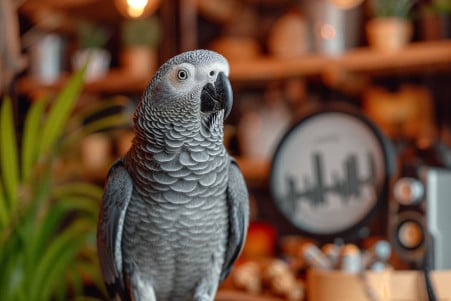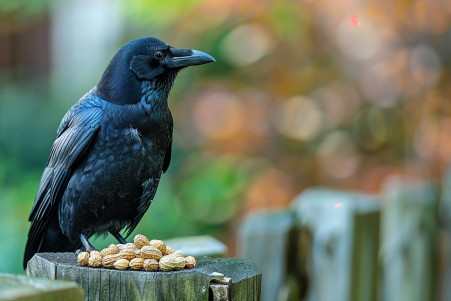What Do Crow Sounds Mean? A Look at Their Intelligence
6 April 2024 • Updated 5 April 2024

From the classic "caw caw" to a wide variety of other calls, the many sounds of crows have meanings and uses that provide insight into the complex social and survival behaviors of these intelligent birds. Crows have a larger vocal repertoire than many other birds, with more than 30 different calls that they use for everything from warning of danger and marking their territory to letting others know they're ready to mate, calling their families together, and simply keeping in touch with their social groups. These calls are specific to different situations and are important at all stages of a crow's life.
In this article, we'll explore the work of avian biologists and wildlife ethologists who have studied the communication of corvids, including crows, and learned that the communication of these birds is more complex than we ever imagined. By the end, you'll have a kind of crow sound dictionary that will help you understand the many calls and the situations in which they are used. You'll also learn what the crows' communication says about their intelligence and social lives and how scientists are using recordings to learn even more about the hidden lives of these smart, misunderstood animals.
What do the different sounds made by crows mean?
The Diverse Repertoire: Categories of Crow Calls
The diverse repertoire of crow vocalizations extends far beyond the familiar "caw" call. According to Nature Mentor, crows have two main categories of vocalizations: "companion calls" and "context calls." Companion calls are short bursts of similar caw sounds used for basic communication, while context calls fluctuate in volume, pitch, and intensity to convey specific events like predator alerts or territorial disputes.
Within these categories, crows use a variety of sounds. The Outside Story explains that differences in the tone, repetition, and timing of a caw can all change its meaning, comparing crow language to tonal human languages like Mandarin. In addition to these calls, crows also use a variety of other sounds, including rattles, clicks, and coos, although the meanings of these calls are less well understood.
Scientists like Kevin McGowan of the Cornell Lab of Ornithology have been able to identify the meanings of some of these calls, such as the faster version of the caw call that sounds like "cawcawcaw," which is used to warn of a hawk flying nearby. However, Bird Watcher's General Store notes that even with these successes, researchers have been less successful at identifying the meanings of more complex calls like the chuckling call or the rattle call.
As bird researchers continue to learn more about the details of crow communication, the complexity and diversity of crow calls make it clear that much more research is needed to understand this fascinating ability. If scientists can figure out the meanings and syntax of crow calls, it could provide important information about the birds' cognitive and social abilities.
Vocal Learning and Development in Crows
The vocalizations of crows change as they grow and develop, and there are many differences between the calls of young crows and those of adults. According to Audubon, adult crows do not sing loudly to attract mates from a distance like other species. Instead, they use a complex combination of soft cooing, rattles, growls, and bowing movements in close-range courtship. These courtship calls are unique to each social group, and they develop into a kind of "cultural tradition" or "dialect" that helps crows identify each other.
Crows also have a high degree of cognitive control over their vocalizations, as shown in a study in which carrion crows were trained to produce or suppress calls based on visual cues. This indicates that songbird vocalizations, including those of crows, are under top-down control from higher cognitive areas of the brain.
The development of these complex vocalizations is also heavily influenced by social learning, as young crows learn from the older members of their social groups. In fact, research has found that crows can learn specific calls, including those for courtship and territorial defense, from their parents and other adults. This social learning may also be responsible for the development of cultural traditions or "dialects" within different crow groups.
Learning more about the details of how crows learn and develop their vocalizations can tell us a lot about their cognitive and social intelligence. As we learn more about how crows communicate, the role of social learning and the possibility of cultural transmission of vocal traditions will be a topic of interest and investigation.
Mimicry and Interspecies Communication
Crows are famous for their ability to mimic a variety of sounds, including human speech and the calls of other animals. As noted by Britannica, corvids like crows and magpies have long been recognized as some of the smartest birds, and their "inquisitive, playful, and able" mimicry is one of the reasons why.
Chirp Nature Center lists examples of crows mimicking everything from the call of a maid to chickens to the calls of hawks and other predators. The reasons for this mimicry range from deterring predators to attracting mates to even playing pranks, as noted by zookeeper Gerald Durrell and his pet magpies.
The anatomical and neurological basis for vocal mimicry in crows is one way that they differ from their primate relatives. As described by Corvid Research, birds like crows have a vocal organ called the syrinx that allows for more vocal flexibility and control than the larynx found in humans and other mammals. This, along with specialized neural connections in the corvid brain, makes their mimicry possible.
Although the exact causes and reasons for crow mimicry are still being studied, it's clear that this ability is yet another example of the cognitive and behavioral complexity of these intelligent birds.
Coordinating Social Behaviors with Vocal Communication
Crows' complex vocal communication is essential for enabling cooperation, collective decision-making, and other advanced social behaviors in their close-knit family units. As the University of Washington's research notes, crows have calls that are used to gather family members, coordinate foraging activities, and maintain social bonds. For example, a faster "cawcawcaw" can alert the group to an incoming predator, enabling a coordinated response.
Vocal communication is also important in competitive interactions, like when crows are defending territories or other resources. A study in Frontiers in Physiology showed that the brain areas in crows that are involved in social interactions and decision-making are more active in response to conspecific vocalizations, especially when food is involved. This indicates that crows use auditory and visual information to determine their social position and adjust their behavior accordingly.
Subsequent research has shown that the nidopallium caudolaterale (NCL), a region of the crow brain, is involved in the executive control of volitional vocalizations. A study in Cell Reports demonstrated that changes in the baseline activity of the NCL can influence crows' decisions to vocalize, which shows the cognitive control that crows have over their vocal communication.
Crows' ability to use their complex vocalizations enables them to coordinate social behaviors, maintain social bonds, and negotiate the complexities of social competition in their communities. As we learn more about the neurological basis of their vocal communication, we also learn more about the cognitive complexity and social acumen of these amazing birds.
Social Learning and Vocal Development
The complex vocalizations of crows are learned and, as a result, social learning plays a major role in the development of their vocal abilities. This is especially true for young crows, who learn from and interact with older members of their social groups. In fact, a study of New Caledonian crows published in Phys.org showed that young crows don't imitate the behavior of older crows but instead exhibit a form of "stimulus enhancement" where they are more likely to interact with a space or object if they see a conspecific doing so. This suggests that the crows are learning the goal of the behavior, in this case, the vocalization, rather than the behavior itself.
Another important form of social learning in crows is vertical transmission, which is when parents teach their offspring specific vocalizations. For example, a study of American crows published in the journal Behavioral Ecology showed that even though young crows didn't see their parents' reactions to a "dangerous" human mask, they eventually learned to respond to it in the same way their parents did. This demonstrates that information about potential threats can be passed down from one generation to the next through social learning.
In addition to learning from their parents, crows are also known to learn from a variety of social partners, including other juveniles, adults, and even members of other crow groups. A study of New Caledonian crows published in the journal Learning & Behavior suggested that this flexibility in social learning may help the transmission of vocal traditions and "dialects" within and between different crow populations.
As we learn more about how crows learn and develop their vocalizations, the role of social learning and the potential for cumulative cultural transmission of vocal traditions will no doubt continue to be a source of interest and investigation.
Conclusion: Unraveling the Hidden World of Crow Communication
Crows’ ability to mimic a wide variety of sounds, including human speech and other animals’ vocalizations, is truly amazing. According to Britannica, corvids like crows and magpies have long been recognized as some of the most intelligent birds, and their “inquisitive, playful, and able” mimicry is one of the reasons why. Chirp Nature Center lists examples of crows mimicking everything from a maid’s call to chickens to the calls of hawks and other predators.
The reasons for this mimicry range from deterring predators to attracting mates and even playing pranks, as Gerald Durrell discovered when he kept magpies as pets. The anatomical and neurological basis for this vocal mimicry is what really sets corvids apart from primates. As Corvid Research explains, birds like crows have a vocal organ called the syrinx that allows for more vocal complexity and control than the larynx that humans and other mammals have. This, along with specialized neural pathways in the corvid brain, makes their mimicry possible.
Although the specific reasons and functions of crow mimicry are still being studied, it’s clear that their ability to mimic sounds is another example of the cognitive and behavioral flexibility of these highly intelligent birds.


